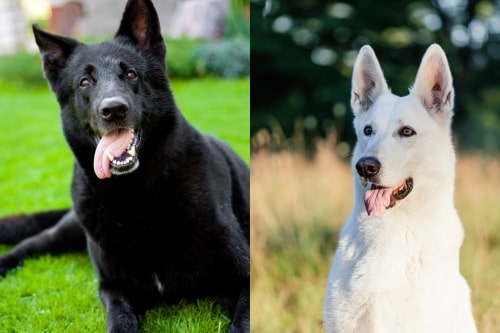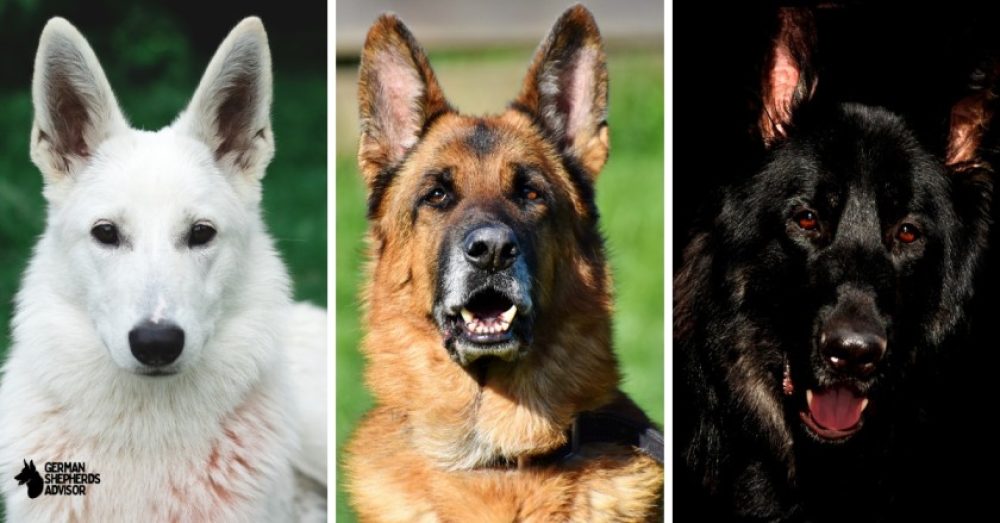Is the german shepherd rare color?
The German shepherd breed is popular and loved by families and dog enthusiasts worldwide. They are intelligent, loyal, and friendly watchdogs that enjoy playing with their masters or participating in canine sports such as agility or obedience. To know all about German shepherd rare color, keep reading this article, and you will get in-depth knowledge.
The most common colors for this breed of dog are tan, black, and tan, sable (ranging from light to dark variations), all shades of red (from light cream red to mahogany), grey and white; there also exist some rarer colours patterns such as silver/grey or pure white shepherds with pale pinkish noses and eye rims.
Two main genes play a role in determining the color of a German Shepherd: the base coat (genotype Bb Dd) and the black masking gene (genotype B_ dd).
With so many different colors, below are five of the rarest colors.
- Panda German Shepherd
- Liver German Shepherd
- Sable German Shepherd
- White German Shepherd
- Black German Shepherd
The base coat is a dominant trait, so when the dog has two copies of this allele, it will be solid in color even if the dog carries a recessive allele for one or more of the other alleles.
The possible colors depend on whether or not the dog carries at least one copy of each allele (the D and D alleles) which determines if there will be any eumelanin (brown to black pigment) present in the animal. I.e., a bbDd genotype would mean that there is no/very little brown pigment present, and such dogs are red.
A B_ Dd genotype
A B_ Dd genotype means that no/very little black pigment is present and results in a white dog. Dogs that are bbdd or B_ dd will have black hair, usually around the face and ears, and are called sable Shepherds.
The black masking gene (B) is a recessive allele, and when present in double dose (homozygous), it masks all other colors, including the base coat color, so that the dog appears solid black. So a dog with genotype BbDd will have a black mask over its head and body regardless of its base coat color.
Molecular Genetics and Genomics
A recent study published in the journal “Molecular Genetics and Genomics” by a team of European researchers has identified seven new German shepherd rare color variants. The study was undertaken better to understand the genetic background of the German shepherd dog and to find new markers for coat color.
German shepherd’s seven new colors
The seven new rare colors are blue, liver, isabella (a very light fawn), wild boar (reddish-brown), black and tan phantom (a black dog with tan points on the body and legs), blue merle (light gray with darker mottling) and sable phantoms (a dark sable with light tipping on the hairs).
While some colors may not be common, they are all within the breed standard and can be shown in confirmation events. So if you are lucky enough to have one of these beautiful dogs in your life, be sure to take it out and show it off not!
The German shepherd is a popular dog breed that comes in various colors. While the most common colors are tan, black, and sable, there are also some rarer colors, such as blue, liver, and isabella. Two main genes play a role in determining the color of a German shepherd: the base coat gene and the black masking gene.
Base coat gene
The base coat gene is dominant, so when the dog has two copies of this allele, it will be solid in color even if the dog carries a recessive allele for one or more of the other alleles. The possible colors depend on the alleles for other coat colors. The black masking gene hides all possible colors except solid ones, so a dog with two copies of this allele will always be solid in color.
The base coat gene has three alleles: B (full color), b (reduced color), and b’ (i.e., recessive red). The possible coats have been described here. BB or Bb dogs will appear to be full color, but there is a wide variation across breeds as to what “full color” means.
The most common German shepherd appears to have a black overlay on top of its sable fur, but this may not actually be true black but just very dark brown/red. In some German shepherds, the base color is a dark liver or isabella instead of red/brown.
To have a blue coat when both parents are BB or Bb, the dog must be bb because the recessive red allele covers up all other colors. The black masking gene has two alleles: M (masked) and m (not masked). Dogs that are MM will appear solid in color while.
Are blue German shepherds rare?
Are they rare, or do you hear about them more often? Blue German shepherds are indeed becoming more popular in the United States. But what about the rest of the world? There isn’t an abundance of these dogs around, but they are getting easier to come by (online, at least).
The answer is a resounding YES – blue German Shepherds ARE RARE. In fact, not only did I have a hard time finding a picture of a gorgeous blue GSD online, but so did some people in my discussion group! Here is the most beautiful photo I found of a blue German Shepherd.
Interestingly enough, the AKC (American Kennel Club) does not accept this dog breed as an official breed. So, you will not find them in the AKC’s registry. Why? It may have something to do with their rarity.
According to the American Kennel Club, only about 10,000 German Shepherds are registered each year in the United States – out of a population of over 74 million people! And how many of those are blue? I’m sure the number is extremely small.
The answer is YES – blue German shepherds are rarer than the standard black and tan. This is because they are a recessive gene, and most breeders will not recognize them as the German Shepherd breed. These dogs come in varying shades and sometimes have somewhat bluish or purple mucus membranes (mucous membranes).
They also usually have white markings, just like their more common counterparts. Blue shepherds can be recognized by anyone familiar with this particular dog color. And that’s not everyone! Are blue German Shepherds RARE? Yes! There needs to be more info on these beautiful dogs in cyberspace if you google “blue German shepherd.
What is Sable GSD?

Sable GSD is a coat color variant of the German Shepherd Dog. It is caused by the recessive sable gene, which affects melanin production in the dog’s hair. This results in a black coat with tan markings, most commonly on the muzzle, chest, and paws. Some sable GSDs may also have a small amount of white fur on their chest or head.
The sable gene is uncommon in German Shepherds, occurring in around 10% of dogs. As a result, sable GSDs are often sought after by breeders and owners. They are considered to be very desirable due to their striking appearance and unique coloration.
Sable GSDs can vary in shade, with some appearing almost black and others appearing reddish or brownish. These variations are caused by modifiers that affect melanin production in different parts of the dog’s body.
Sable German shepherd gene
The gene for sable is recessive. As a result, both parents must be carriers for this color to appear in their offspring. Dogs with two copies of the sable gene are more intensely colored than those with only one copy, but they are usually not allowed to breed due to concerns about health issues linked to the presence of large amounts of melanin in the coat. Sables may be bred with other coat colors if their partners do not carry the sable gene.
Sable GSDs have dorsal hairs that are either black or very dark brown, while ventral hairs are usually lighter. They may also have a dark mask and black ears. The coat is shorter on the face and legs and longer around the neck and body.
Sable GSDs are intelligent, energetic, and working dogs that make good companions. They require plenty of exercises and can be prone to barking without enough stimulation. They can be excellent family pets with proper socialisation and training.
If you are considering adding a sable German Shepherd to your family, research the breed carefully and find a reputable breeder who health tests their dogs. Sables can be beautiful additions to any home but require some extra care.
Red merle German shepherd
While a red merle German shepherd may not be the most common of colors, they are still just as beautiful and majestic as any other German shepherd color. With their striking red and black markings, they can turn heads wherever they go.
Red Merle German shepherds are a result of combining two different colors of Merle genes. This creates a unique and beautiful coat pattern not found in any other dog breed. Their predominantly red coat with black markings easily distinguishes them from other German shepherds.
Their temperament is just as wonderful as their appearance. They are typically very friendly, playful, and loving dogs that are great family pets. They are also known to be very intelligent dogs, which makes them very easy to train. Red merle German shepherds are always eager and willing to please their owners and will put much effort into doing so.
You should consider getting one if you still need a red Merle German Shepherd. Their bright and happy disposition can lift anyone’s mood under challenging times, and they would make excellent pets for almost any family.
Can German shepherds be black and white?
Many people have wondered if a black and white German shepherd is possible. While most German shepherds are black and tan, there may be some out there that are predominantly white.

This article will answer the question, “Can a German shepherd be all black?” Unfortunately, for those who want to see a color other than black and tan, the consensus from breeders is that it’s not likely. There might be some lucky family out there who has found an authentic German shepherd that is nearly all-white in color.
Still, these dogs are usually unhealthy or show signs of carrying another recessive gene mutation–such as one for piebaldism or ataxia. Some of these genes can cause significant health problems in the dog, so it’s important to know what you could get into if you consider a black and white German shepherd.
There are many wonderful blacks and tan German shepherds out there who make great family pets, and those looking for one of these dogs should not be discouraged by the possible appearance of a black-and-white pup.
Breeding for color is not as important as breeding for good health, temperament, and structure, so anyone interested in adding a German shepherd to their family should visit a reputable breeder instead of relying on online ads or pet stores.
Final words about German shepherd rare colors
There are many different colors that German Shepherds can be. Some of the most popular colors include black, tan, and sable. However, there are also some unique colors that German Shepherds can come in, such as blue and liver. While these colors are not as common, they can still make for beautiful dogs.
If you want a German Shepherd but have to decide on a colour, consider all your options first. Each color has its own unique set of characteristics and personality traits. For example, black German Shepherds are often seen as loyal and protective, while sable German Shepherds are known to be friendly and playful.
No matter what color you choose, you can be sure you will get a beautiful and loyal dog. So, take your time choosing the perfect color for your new German Shepherd, and be prepared to enjoy all the beautiful things that come with it!

